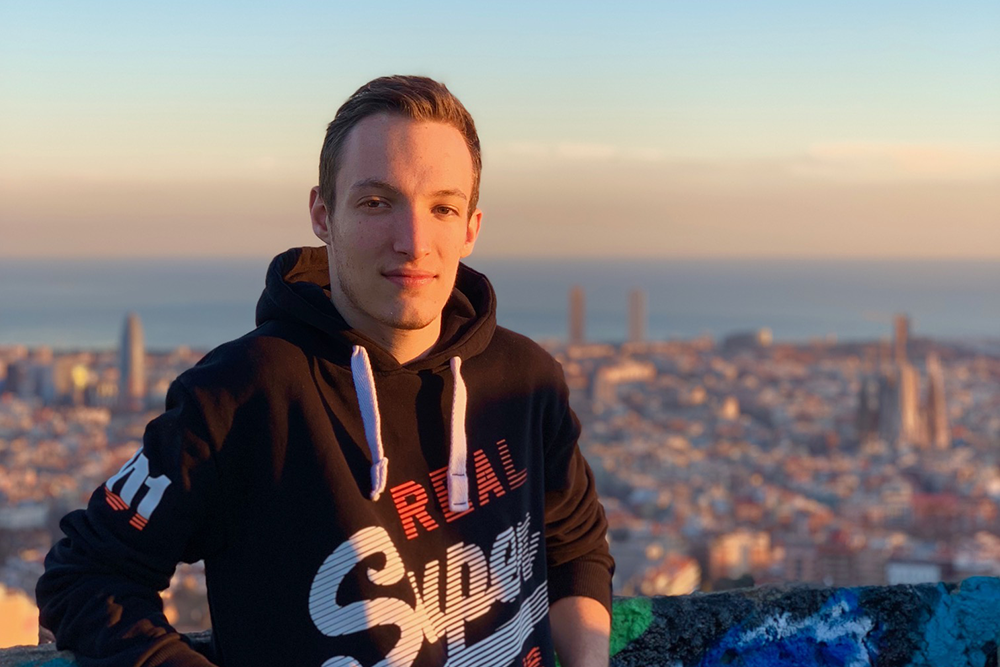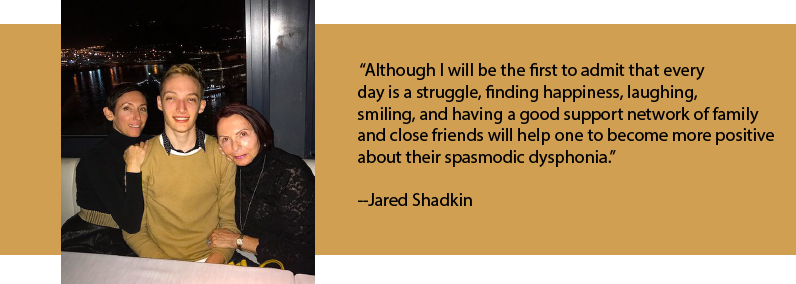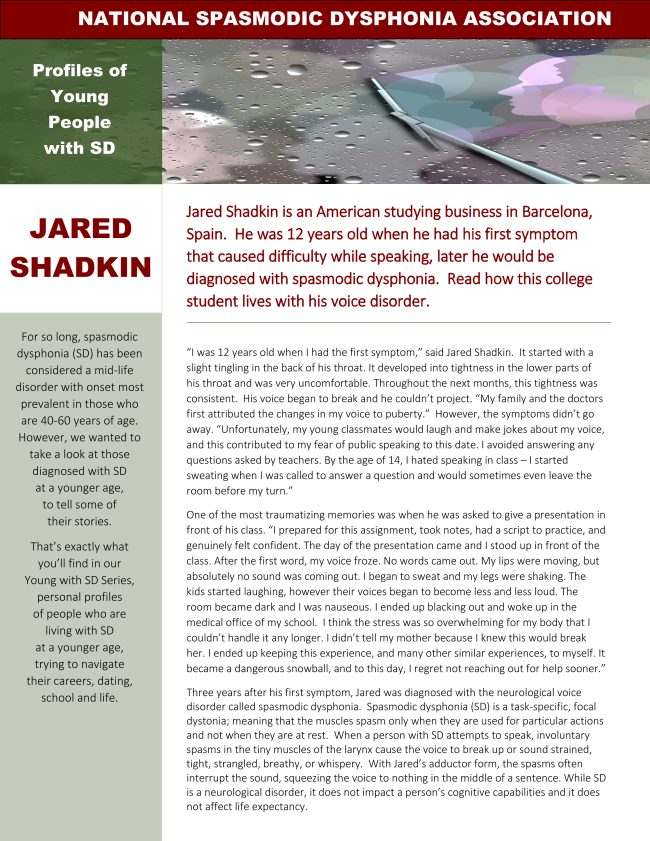Jared Shadkin has SD and won’t let this diagnosis bring him down
Jared Shadkin is an American studying business in Barcelona, Spain. He was 12 years old when he had his first symptom that caused difficulty while speaking, later he would be diagnosed with spasmodic dysphonia (SD). Read how this college student lives with his voice disorder.
His first symptoms started at 12

“I was 12 years old when I had the first symptom,” said Jared Shadkin. It started with a slight tingling in the back of his throat. It developed into tightness in the lower parts of his throat and was very uncomfortable. Throughout the next months, this tightness was consistent. His voice began to break and he couldn’t project. “My family and the doctors first attributed the changes in my voice to puberty.” However, the symptoms didn’t go away. “Unfortunately, my young classmates would laugh and make jokes about my voice, and this contributed to my fear of public speaking to this date. I avoided answering any questions asked by teachers. By the age of 14, I hated speaking in class – I started sweating when I was called to answer a question and would sometimes even leave the room before my turn.”
One of the most traumatizing memories was when he was asked to give a presentation in front of his class. “I prepared for this assignment, took notes, had a script to practice, and genuinely felt confident. The day of the presentation came and I stood up in front of the class. After the first word, my voice froze. No words came out. My lips were moving, but absolutely no sound was coming out. I began to sweat and my legs were shaking. The kids started laughing, however their voices began to become less and less loud. The room became dark and I was nauseous. I ended up blacking out and woke up in the medical office of my school. I think the stress was so overwhelming for my body that I couldn’t handle it any longer. I didn’t tell my mother because I knew this would break her. I ended up keeping this experience, and many other similar experiences, to myself. It became a dangerous snowball, and to this day, I regret not reaching out for help sooner.”
Diagnosis three years after first symptom
Three years after his first symptom, Jared was diagnosed with the neurological voice disorder called spasmodic dysphonia. Spasmodic dysphonia (SD) is a task-specific, focal dystonia; meaning that the muscles spasm only when they are used for particular actions and not when they are at rest. When a person with SD attempts to speak, involuntary spasms in the tiny muscles of the larynx cause the voice to break up or sound strained, tight, strangled, breathy, or whispery. With Jared’s adductor form, the spasms often interrupt the sound, squeezing the voice to nothing in the middle of a sentence. While SD is a neurological disorder, it does not impact a person’s cognitive capabilities and it does not affect life expectancy.
“Realizing that my voice was quite literally stolen from me was so hard to bear. Our voices are our key to the world. Our voice is freedom. And my voice was being taken away from me. The simplest tasks became the hardest.” Jared admits to going through a serious bout of depression. He didn’t speak much after that point, didn’t hang out with friends, and had a hard time concentrating in school. “Two weeks after my diagnosis, I decided to take a walk and sat by the beach in Puerto Rico. I realized that I have family and friends who love me, I am mostly healthy, and I can do anything a regular teenager can do. I have been blessed with so many positives, and I didn’t want to let this diagnosis bring me down. My future happiness and endeavors were in jeopardy, and I was determined that I couldn’t let this mental pain confine me and my dreams.”
Jared finds the NSDA and the right doctors
Jared starting doing online research and found the NSDA website. He found information on doctors and treatment types. Thanks to the “Healthcare Referral” Page on the NSDA website, he was able to find a doctor and start treatment just weeks after his diagnosis.
Thankfully, Jared’s family has been really supportive of his quest for symptom relief. They have enabled him to travel and seek the best care. After speaking with his neurologist and specialists in the field of SD, Jared found hope. He started receiving botulinum toxin (Botox®) injections to help counteract the spasms and pain he felt when speaking. He sees Dr. Andrew Blitzer in New York or Dr. Hicklin in London, England. “Thankfully, the shots have had extremely positive results. Aside from the 1-2-week downtime when my voice is very faint, I tend to regain 90% of my voice for a three-month period.” He describes the Botox® injection itself as a relatively painless and fast procedure.

Boxtox® works for Jared
Botox® works by blocking the neurotransmitter acetylcholine, causing the larynx muscle to weaken. It causes paralysis of the muscle 24-48 hours after injection. Then, after an initial breathy period, it is followed by a near normal voice for about three months. SD is well suited for treatment with Botox® because the larynx is easy to access, the muscles are clearly differentiated, the areas impacted are visible and doctors can see the muscle to confirm the proper placement of the injection.
“I couldn’t be happier that patients afflicted with SD have a method for regaining their voices,” Jared said, referring to Botox®. “The shot itself involves a quick pinch and lasts no longer than one minute. Some injection site pain may follow for the day, but subsides quickly. Two, quick 15-second injections into the throat and I’m free to continue my day.”
Talking about SD
Aside from immediate family members, Jared has only ever told teachers in school about his diagnosis. “SD can have a direct effect on my performance, especially when required to do an oral presentation.” But he has not told any of his close friends – not because they would treat him differently, but because he doesn’t think he has been able to come to terms with his disorder on a personal level. “Being an independent person, there is a great mental burden regarding the fact that I will always be reliant on doctors and Botox® shots every three months for the rest of my life. Although this doesn’t consume my life on a daily basis, I have moments where this does consume my inner-most emotions and thoughts.” He admits that from time to time, he gets strange looks when speaking, or people ask him to repeat himself. The most nerve-racking is when people ask him if he is sick, or if this is his normal voice. It’s those moments when his confidence wanes.
“I know my family and close friends are supportive, and of course there are moments when we are talking in particularly loud places that it becomes frustrating for both sides when I can’t communicate, and they realize the reason why.” With regards to others around me, I would hope that they do not treat me any differently because of my voice or think of me any less because of it.”
Like some with SD, Jared has been diagnosed with another dystonia. He also has DYT1 Dystonia which affects his limbs and hands. For this, he has had very successful Deep Brain Stimulation surgery.
Surrounding himself with support
“I am always surrounded by friends and professors, people in after-school sports and at parties and I am lucky to have such success with Botox®, because I know some people haven’t. This allows me to create friendships and partnerships that are crucial for a fruitful life”. The only way to do this, according to Jared, is by speaking on a daily basis. He says that people who are older, those not surrounded by large support groups (like he has at school) or who are not having successful treatments might greatly limit their interactions with others. It’s this that he points to which might make SD different for young people. “Although I will be the first to admit that every day is a struggle, finding happiness, laughing, smiling, and having a good support network of family and close friends will help one to become more positive about their spasmodic dysphonia.”
His future
“My dream is to become a successful stock trader, like my father.” Although he does not believe SD will limit his job opportunities in the future, he believes that working for himself will help take the daily struggle of SD out of the equation. “I would hope in the future I am financially stable and, in a position, to not worry about the costs associated with receiving Botox® injections. There are so many stories on the SD Facebook group pages where people struggle with their bills, the sky-high prices, and some instances, where insurance does not cover injections.” Working as a trader would allow him freedom to continue to travel and see the best doctors.
Advice from Jared to others with SD
“In Spanish, there is a saying, “Poco a Poco,” or, “Little by Little.” You need to take each day slowly and find joy in the smallest of things. This can be as simple as listening to your favorite music, reading a book, going to dinner with family, or watching the sunset. For others struggling with a similar situation, Jared says. “Keep your head up, stay strong, and enjoy every moment. That’s how I live and thrive with my Dystonias.”



